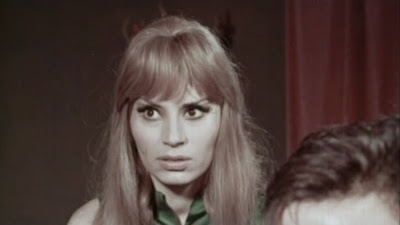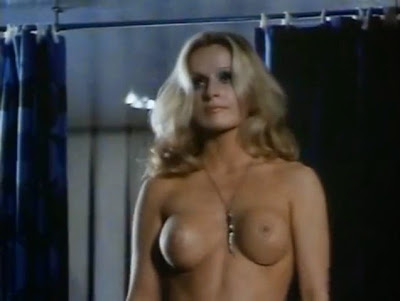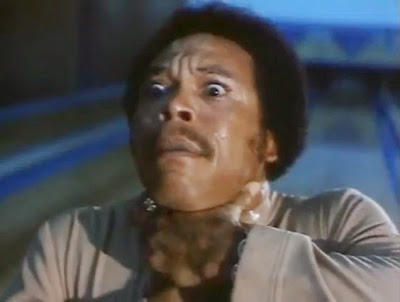Italy, 1968
Directed by Renato Borraccetti
Cast:
Jack Taylor, Aichè Nanà, Gia Sandri, Barth Warren, Dan Daniels, Diego Parravicini, Augusto Bonardi, Ignazio Balsamo, Fabio Testi, Angela De Leo
Directed by Renato Borraccetti
Cast:
Jack Taylor, Aichè Nanà, Gia Sandri, Barth Warren, Dan Daniels, Diego Parravicini, Augusto Bonardi, Ignazio Balsamo, Fabio Testi, Angela De Leo
One of the most obscure Italian genre films of the 1960s, Due occhi per uccidere – the only film produced by Milanese production company Daniels Film – was the fourth and final film directed by the elusive Renato Borraccetti, whose previous three films had all been melodramas. With Due occhi per uccidere (i.e. Two Eyes to Kill) the little-known filmmaker tried his hand at a crime movie but found little success: after a brief theatrical run in 1968, it vanished into complete obscurity and was never issued on VHS anywhere in the world. It reportedly aired on an Italian TV channel back in the 1980s but no recordings of this broadcast are known to exist – damning the film to complete unavailability.
This finally changed in 2014, when DjangoLi of the LoveLockAndLoad forum was able to snap up a 35mm version of the film on eBay. The film prints were badly degraded and terribly scratched, and needed to be cleaned up and telecined – a costly endeavor that was only made possible due to a fundraiser at the LoveLockAndLoad forum (I was one of the lucky contributors who got to play a small part in rescuing this rarity) and the film is finally back after 46 years of unavailability. Unfortunately, the guy who sold this 35mm version on eBay only had 3 of the 4 reels. The third reel (amounting to around 15 to 20 minutes) is missing, so this rediscovered version only runs 55 minutes. The missing footage is certainly regrettable, but do not let that discourage you – the fact that this film is finally available at all is still of great significance for aficionados of rare Euro cinema.
But what’s Due occhi per uccidere like then? I’ve seen it described as a giallo but I wouldn’t really categorize it as such. It’s more of a low-rent crime movie with a few vague thriller, horror and spy motifs thrown into the mix. It’s set in France, and begins by introducing us to a man named Jean (played uncredited by a young Fabio Testi), who is sentenced to death for an unspecified crime. He’s allowed to keep his beloved trumpet with him on the night before his execution, and he spends the night playing a moody jazz tune. The next morning he is brought to the gallows and executed by guillotine in spite of his staunch proclamations of innocence.
Poor Jean meets a grisly fate
Cut to a year later in a French nightclub run by Max (Jack Taylor), a leering and thoroughly despicable gangster who is running all kinds of illegal operations from his club. Unbeknownst to Max, his office is being monitored through some sort of fancy surveillance machine set up by Rosy (Gia Sandri), one of the dancers from his club, and her friend Pierre (Barth Warren). Pierre is operating the machine from a secret location and is staying in contact with Rosy through a high tech listening device implanted in her big, funky glasses and controlled by her blinking cigarette box!
The slimy Max
Pierre and Rosy operate their fancy surveillance equipment
Rosy and Pierre are out to get Max, and thanks to their secret monitoring they are able to sabotage some of his criminal operations, as well as alienating him from his dancer-girlfriend Nadia (Aichè Nanà) by sending her to Max’s office just as he’s about to rape a hapless underage girl (played uncredited by Angela De Leo from Night of the Damned, 1971).
Max assaults a helpless girl...
...but gets caught in the act by his furious girlfriend
It eventually transpires that Pierre and Rosy were close friends of Jean, the young man who was guillotined at the start of the film, and they are convinced that Max is the one who’s really responsible for the crime Jean was executed for. They continue to torment Max by sending him the gun used to commit the crime, and by playing the tune that Jean loved playing on his trumpet...
Max is gradually driven to madness and paranoia
As wonderful as it would be to proclaim that Due occhi per uccidere is a lost classic that has finally been unearthed after more than 45 years of unavailability, the truth is that it’s easy to see why this one faded into obscurity in the first place. It just isn’t a very good film – plagued by a meandering plot that moves along at a plodding pace, and by Borraccetti’s heavy-handed direction, which is unable to infuse the story with any sort of tension. Most problematic by far, however, is the fact that nothing much ever seems to happen. I mean, there’s around 15-20 minutes worth of footage missing and yet it didn’t feel as if anything was missing when I watched it, and that should give you a pretty good idea of just how hopelessly uneventful this whole mess is! I have no idea what goes on in that missing reel, but it can’t have been a whole lot.
The film’s uneventfulness is probably at least partially a byproduct of the fact that it’s a terribly cheap production whose impoverished nature is made apparent by its rampant use of curtains instead of walls, the pitiful-looking surveillance machine made out of cardboard, a barely furnished police communications room, and a setting that is confined almost exclusively to the nightclub.
The sorry-looking police communications room
One of the numerous instances of curtains being used instead of walls
Yet, in spite of the film’s all-around incompetence, I confess to still finding Due occhi per uccidere impossible to dislike – due in part to its great rarity, but also because it possesses that very peculiar and hard to define charm that only the strangest of zero budget Euro-oddities do. The high points include Piero Umiliano’s moody jazz score accompanied by the great trumpeter Nini Rosso; the opening sequence in which Fabio Testi is led to the scaffold; Aichè Nanà’s sexy and bizarre nightclub act; and the sequence portraying how Max’s sanity starts to crack, with the light flickering and the camera frenziedly zooming in and out on his sweaty, anguished face. I also like how the high-tech surveillance machine and the radio communication device in Rosy’s glasses lend a small Eurospy vibe to the proceedings, and altogether the general WTF-ery of the piece is a definite plus.
And then there is of course the great Jack Taylor (a familiar face to all fans of Spanish horror and exploitation cinema), who is very nicely cast as the slimy and loathsome Max. He’s pretty over the top but is very enjoyable to watch and brings a delightful and much needed intensity to an otherwise rather low-octane effort. Taylor did this film around the same time that he appeared in Succubus (1968), the first in a long line of films he did for ultra-prolific Spanish filmmaker Jess Franco. And indeed, Taylor’s presence here, together with the moody jazz score, bizarre nightclub acts, singular setting and zero budget atmosphere lend somewhat of a Franco-esque ambience to the film – which may be a good or a bad thing, depending on how you feel about the eccentric Spaniard.
Jack Taylor is all kinds of awesome in the role of Max
The film also boasts a delightfully sexy performance by Lebanese-born actress/dancer Aichè Nanà, who became a tabloid sensation in Italy in 1958 when she performed a scandalous striptease in a star-packed Roman nightclub – a sensationalized event that served as the inspiration for a famous sequence in Federico Fellini’s La Dolce Vita (1960). The incident propelled Nanà into a film career in the 1960s, but she never really landed roles in anything but cheap and barely released films such as the early giallo A... come assassino (1966), or obscure spaghetti westerns like Chrysanthemums for a Bunch of Swine (1968), directed by her then-husband Sergio Pastore. As such, Nanà was right at home appearing in Due occhi per uccidere, but it should be said that she really comes off quite good here. Not so much because of her exaggerated, eye-rolling performance, but rather for her sexiness and for providing one of the film’s most memorable moments when she performs a weird nightclub dance that turns even weirder when a bare-chested guy with an animal mask enters the stage and starts cracking a whip at her.
Aichè Nanà’s bizarro dance routine
The only other substantial roles in the films are those of the avenging duo played by Gia Sandri and Barth Warren, about whom not much is known. Warren only appeared in a handful of films but was a very prolific photo-novel actor under the name Bart Anera. His photo-novel career consisted, almost without exception, of villainous roles, and his face is indeed better suited to such parts than to the one he is playing here. Unlike Warren, Sandri actually appeared in a fair number of films throughout the 1960s – above all in spaghetti westerns as well as a couple of comedies with Franco and Ciccio – but without ever making it big, which is a pity as she’s very attractive and charming here.
Barth Warren and Gia Sandri as the film’s avenging couple
Due occhi per uccidere is a very strange and peculiar film that is unlikely to appeal to most viewers, but it’s a terribly fascinating work that is great to finally have seen. It’s certainly no lost classic, but Jack Taylor fans and admirers of zero budget Euro-oddities will surely want to check it out!
© 2015 Johan Melle
The cast:
Jack Taylor as Max
Aichè Nanà as Nadia
Gia Sandri as Rosy
Barth Warren as Pierre
??? as Chéri
??? as The Rat
Augusto Bonardi as Gregoric
Diego Parravicini as Commissioner Marbel
Fabio Testi as Jean
Angela De Leo as Josette










































































